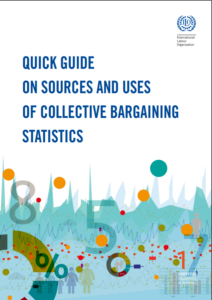Table of Contents
Related pages
Introduction
Ensuring adequate working conditions is crucial for our well-being and that of our families. Social dialogue – which includes negotiations and consultations among labour market actors, collective bargaining and dispute prevention and resolution – helps promote adequate working conditions, peace, and social justice. Successful social dialogue can resolve economic and social issues and effectively address economic crises, impacting stability, labour market governance, and the economy.
Unions are independent workers’ organizations constituted for the purpose of furthering and defending the interests of workers. As such, they play a key role in the quest to achieve better remuneration and working conditions. Similarly, the scope, coverage and frequency of collective bargaining, the items negotiated and the outcome of negotiations have a great impact on workers’ conditions. Meanwhile, grievances and conflicts are an inevitable part of the employment relationship. The objective of public policy is to manage conflict and promote sound labour relations by creating a system for the effective prevention and settlement of labour disputes. The number, frequency, duration and scope of strikes and lockouts all have a great impact on the labour market, the economy and workers’ well-being.
To assess the extent of social dialogue, reliable data on unions and unionization, employers’ organizations, collective bargaining and industrial disputes is essential. This page presents statistics and other information on these topics.
Data catalogue
| Indicator | Frequency | Database | Subject | Download (with labels) | Download (with codes) | Data explorer |
|---|---|---|---|---|---|---|
| Trade union density rate (%) | Annual | Industrial Relations Data (IRdata) | Trade union membership | .csv .dta .xlsx | .csv.gz | |
| Collective bargaining coverage rate (%) | Annual | Industrial Relations Data (IRdata) | Collective bargaining | .csv .dta .xlsx | .csv.gz | |
| Number of strikes and lockouts by economic activity | Annual | Industrial Relations Data (IRdata) | Strikes and lockouts | .csv .dta .xlsx | .csv.gz | |
| Days not worked due to strikes and lockouts by economic activity | Annual | Industrial Relations Data (IRdata) | Strikes and lockouts | .csv .dta .xlsx | .csv.gz | |
| Workers involved in strikes and lockouts by economic activity (thousands) | Annual | Industrial Relations Data (IRdata) | Strikes and lockouts | .csv .dta .xlsx | .csv.gz | |
| Days not worked per 1000 workers due to strikes and lockouts by economic activity (per 1000 workers) | Annual | Industrial Relations Data (IRdata) | Strikes and lockouts | .csv .dta .xlsx | .csv.gz |
Latest posts
Methods

Industrial Relations Data (IRdata)
Concise description of concepts and definitions, uses, sources and limitations for indicators in the database Industrial Relations Data (IRdata), including collective bargaining and union membership.

About SDG indicator 8.8.2
This page describes the methodology for SDG indicator 8.8.2, which measures the level of national compliance with freedom of association and the effective recognition of the right to collective bargaining for all ILO member states.

Guidebook on how and why to collect and use data on industrial relations
This guidebook is intended to support ILO’s tripartite constituents in the collection of data on industrial relations, including on trade union membership, on the coverage of collective bargaining agreements and on strikes and lockouts.

Quick guide on sources and uses of collective bargaining statistics
Collective bargaining statistics are crucial to assess labour markets but also the state of industrial relations. However, the particularities linked with the data sources and data quality make collective bargaining statistics a very challenging field of labour statistics. Get information about all the main aspects of collective bargaining statistics in this quick guide.

Resolution concerning the methodology of the SDG indicator 8.8.2 on labour rights (including amendments)
Adopted by the 20th ICLS (2018), this resolution sets an internationally agreed methodology to measure indicator SDG 8.8.2 on labour rights consistent with the Resolution adopted by the United Nations General Assembly on Work of the Statistical Commission pertaining to the 2030 Agenda for Sustainable Development (A/RES/71/313), Annex taken on 6 July 2017.

Social Dialogue Indicators Comparative Note: Collecting information through Labour Force Surveys
Freedom of association and the right to collective bargaining are at the core of decent work. They are fundamental rights at work and the foundations of sound industrial relations and effective social dialogue. Data and indicators on trade union membership and coverage of collective agreements, together with other qualitative indicators, are important for monitoring the progress made towards the effective realization of these rights at work.

Decent work statistical indicators: strikes and lockouts statistics in the international context
Based on the analysis of the three major international programmes which aim at the regular publication of international labour disputes statistics, the author argues that currently the measure which best reconciles the number of days lost due to industrial action with the varying sizes of countries’ employed population and provides a reasonable basis for international comparisons is the rate of days not worked due to strikes and lockouts (per 1.000 employees).

Sources and Methods Volume 7: Strikes and lockouts (1999)
This volume contains the descriptions of national statistics on strikes and lockouts.

Resolution concerning statistics of strikes, lockouts and other action due to labour disputes
Adopted by the 15th ICLS (1993), this resolution provides guidelines to assist and improve the production of national statistics on action due to labour disputes and to enhance comparability of such statistics between countries.

Resolution concerning statistics of collective agreements
Adopted by the 3rd ICLS (1926), this resolution defines statistics on collective agreements.
Publications
Note: Many publications are available only in English. If available in other languages, a new page will open displaying these options.


Social Dialogue Report 2022: Collective bargaining for an inclusive, sustainable and resilient recovery
This first edition of this new ILO flagship report focuses on collective bargaining.

Trends in collective bargaining coverage: Stability, erosion or decline?
This issue brief examines differences in collective bargaining coverage for 75 countries. Collective bargaining over wages and other labour conditions between unions and employers is a key labour market institution in democratic societies. The coverage and impact of this institution varies over time and across countries.



